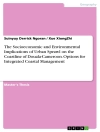This edited volume brings together findings and case studies on fundamental and applied aspects of structural engineering, applied to buildings, bridges and infrastructures in general. It focuses on the application of advanced experimental and numerical techniques and new technologies to the built environment. This volume is part of the proceedings of the 1st Geo MEast International Congress and Exhibition on Sustainable Civil Infrastructures, Egypt 2017.
عن المؤلف
HUGO RODRIGUES is Senior Lecturer at the School of Technology and Management, Polytechnic Institute of Leiria, Portugal, teaching several topics related with Structural Analysis, Building Pathology and Rehabilitation. He received his Ph.D. in Civil Engineering from the University of Aveiro in 2012. His experience in Seismic analysis, having participated as a team member in research and development projects, specialized consultancy studies ordered by several public institutions and companies regarding the assessment of seismic risk. His major research interests are Building Rehabilitation, Structural Health Monitoring and Seismic Safety including experimental and numerical activities. Research member of the RIsks and Sustainability in COnstruction (RISCO). He has co-authored more than 150 publications in top-tier peer-reviewed journals and national and international conferences.
GIAN MICHELE CALVI is Professor at the IUSS Pavia, Italy, and Adjunct Professor at the North Carolina State University. He received a Master of Science from the University of California, Berkeley, a Ph D from the Politecnico di Milano and a Honorary Doctorate from the University of Cujo, Mendoza, Argentina.
He has been the founder of the Eucentre Foundation and of the ROSE School; he has been a member of the Board of Directors of the GEM Foundation and is one of the Directors of the International Association of Earthquake Engineering.He is author of hundreds of publications and of two major books: Seismic design and retrofit of bridges (with M.J.N. Priestley and F. Seible, 1996) and Displacement-Based Seismic Design of Structures (with M.J.N. Priestley and M.J. Kowalsky, 2007).
He has been designer, consultant or checker for hundreds of structural projects, including the Rion-Antirion cable stayed bridge (2883 m, in Greece), the Bolu viaduct (119 spans, in Turkey) and the new housing system after L’Aquila earthquake (2009), with 185 buildings seismically isolated with more than 7, 000 devices, completed in about six months.
He is associate editor of the Journal of Earthquake Engineering (Taylor and Francis) and editor of Progettazione Sismica (IUSS Press, Pavia), a journal in Italian addressed to practitioners.
He has been invited keynote speakers in tens of conferences, including two World and four European Conferences on Earthquake Engineering.
He has been always active in conceptual innovation in seismic design, focusing on masonry in his early days, on bridges, displacement–based design and seismic isolation from the nineties.
AMR ELNASHAI, Fellow of the British Royal Academy of Engineering, Amr Elnashai is the Dean of Engineering at the Pennsylvania State University, and the Harold and Inge Marcus Chair of Engineering. He was previously head of the Department of Civil and Environmental Engineering at the University of Illinois at Urbana-Champaign, USA and the Bill and Elaine Hall endowed professor in the same department. He was Director of the NSF multi-institution interdisciplinary Mid-America Earthquake Center (2004-2009). He was also Director of the NSF Network for Earthquake Engineering Simulations (NEES) Laboratory at Illinois (2002-2009). Amr obtained his Bachelor of Science degree from Cairo University, followed by M.Sc. and Ph.D. degrees from Imperial College, University of London. Before joining the University of Illinois in June 2001, Amr was Professor of Earthquake Engineering and Head of Division at Imperial College (1985-2001). He has been Visiting Professor at the University of Surrey, UK, since 1997. Other visiting professor appointments include the University of Tokyo, the University of Southern California, and the European School for Advanced Studies in Reduction of Seismic Risk, Italy.
He is founder and co-editor of the Journal of Earthquake Engineering and editorial board member of several other journals, a member of the drafting panel of the European design codes, past chair of the UK earthquake engineering association, UK delegate to and past senior Vice-President of the European Association of Earthquake Engineering and a member of the Council of the UK Institution of Structural Engineers. He is the winner of the Imperial College Unwin Prize for the best Ph D thesis in Civil and Mechanical Engineering (1984), the Oscar Faber Medal for best paper in the Institution of Structural Engineering, and two best paper medals from the International Association of Tall Buildings, Los Angeles.
Amr’s technical interests are multi-resolution distributed analytical simulations, network analysis, large-scale hybrid testing and field investigations of the response of complex networks and structures to earthquakes. He has produced more than 250 research publications, comprising over 140 refereed journal papers and many conference papers, keynote and prestige lectures (including the Nathan Newmark Distinguished Lecture), research reports, 3 books and several book chapters and magazine articles.












